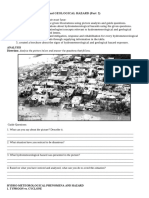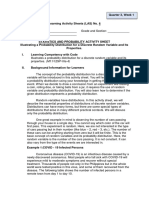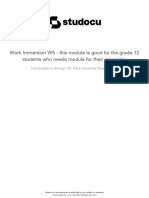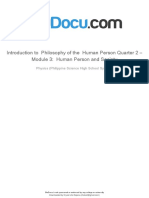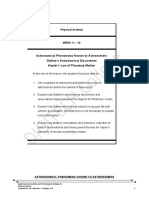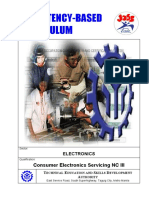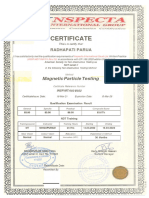DRR Week 1 - 2
Uploaded by
Aleli Joy Profugo DalisayDRR Week 1 - 2
Uploaded by
Aleli Joy Profugo DalisayCourse Description
This course focuses on the application of scientific knowledge and the solution of
practical problems in a physical environment. It is designed to bridge the gap
between theoretical science and daily living.
Digital Communication and Technological College Inc.
Disaster Readiness and Risk Reduction
Prepared by: Ms. Julie May V. Profugo, LPT 1
Disaster Readiness and Risk
Reduction
WEEK 1-2
Basic Concept of Disaster and Disaster Risk
Nature of Disasters
Identifying Hazards That Can Lead to Disasters
Exposure and Vulnerability
At the end of this lesson, the learners will be able to:
1. Explain the meaning of Disaster Risk;
2. Enumerate the risk factors which underlie disasters
3. Describe the effects of disaster to one’s life
4. Analyze disaster from different perspectives (physical,
psychological, sociocultural, economic, political and biological)
5. Distinguish natural events from disasters;
Digital Communication and Technological College Inc.
Disaster Readiness and Risk Reduction
Prepared by: Ms. Julie May V. Profugo, LPT 2
Disasters are a reality. This is especially true in the Philippines where we are visited by
innumerable typhoons each year with their attendant floods; we are situated in an archipelagic
country that sits over a ring of fire and is leashed to an earthquake belt. Perhaps our most
potent response to it must be awareness, knowledge, and understanding of this reality. Hence,
this first lesson provides you, the learner, with a basic but thorough grounding on the concept of
disaster and how and when an event turns into a disaster.
Disaster is “a sudden, calamitous event, bringing great damage, loss, destruction and
devastation to life and property.” (Asian Disaster Preparedness Center, ADPC, 2012)
The preceding definition of disaster stresses that two elements are affected – life (whether
human or animal) and property. The effects vary – it maybe a minor damage (like broken
windows and doors), major damage (like torn rooftops, collapsed walls), total destruction (like
completely destroyed houses and structures rendering them useless and inhabitable) and the
worst of all, death.
The extent of effects also varies. The damages may be confined to a small area or it
reach or encompass an extensive, wide area.
Disaster is “a serious disruption of the functioning of a community or a society involving
widespread human, material, economic or environmental losses and impacts, which exceeds
the ability of the affected community or society to cope using its own resources.”(Food and
Agriculture Organization of the United Nation, FAO, 2008)
BASIC CONCEPT OF DISASTER AND DISASTER RISK
Now that you have a functional understanding of disaster, you must also develop a firm
grasp of a very crucial factor that has direct bearing on disaster. This factor is termed “Disaster
risk.” Other references call this “risk;” so “disaster risk” and “risk” are expressions having the
same meaning.
With this disaster risk, areas have been identified to be prone to disasters.
Risk is “the probability of harmful consequences, or expected losses (deaths,
injuries, property, livelihoods, economic activity disrupted or environment damaged)
resulting from interactions between natural or human-induced hazards and vulnerable
conditions.” (Food and Agriculture Organization of the United Nation, FAO (2008)
Digital Communication and Technological College Inc.
Disaster Readiness and Risk Reduction
Prepared by: Ms. Julie May V. Profugo, LPT 3
Disaster risk is usually described as a function of the hazard and the vulnerability
context, including the resilience of the societal system under threat. (Food and Agriculture
Organization of the United Nation, FAO (2008)
Disaster Risk is “the probability that a community’s structure or geographic area is
to be damaged or disrupted by the impact of a particular hazard, on account of its nature,
construction and proximity to a hazardous area.” (ADPC, 2012).
The three definitions cited above indicate that there are three elements of disaster risk.
1. Exposure: The ‘elements at risk’ from a natural or man-made hazard event. (Quebral, 2016).
2. Hazard: A potentially damaging physical event, phenomenon or human activity that may
cause the loss of life or injury, property damage, social and economic disruption or
environmental degradation. FAO (2008)
3. Vulnerability: The conditions determined by physical, social, economic and
environmental factors or processes, which increase the susceptibility of a community to the
impact of hazards. FAO (2008)
Man-made hazard
Reduction of the level of vulnerability and exposure is possible by keeping people and
property as distant as possible from hazards. We cannot prevent natural events from occurring
so we should focus on addressing the reduction of vulnerability and exposure.
Disasters can affect anyone and everyone. It does not discriminate between and among
social classes, gender, creed, race, nationality. But there are certain risk factors which put those
affected in a position where they will have graver or longer-lasting post-disaster stress
reactions. These aggravating factors contribute pronounced differences in the stress reactions
of certain individuals with certain characteristics.
The risk factors which underlie disasters according to the ADPC (2012) are:
Digital Communication and Technological College Inc.
Disaster Readiness and Risk Reduction
Prepared by: Ms. Julie May V. Profugo, LPT 4
1. Severity of exposure - those who experience disaster first-hand have the
highest risk of developing future mental problems. Next are those in contact
with victims such as rescue workers and health care practitioners.
Of lowest risk are those most distant like those who have awareness of the
disaster only through news.
2. Gender and Family – the female gender (woman or girl) suffers more adverse
effects. This worsens when children are present at home. Marital relationships
are placed under strain.
3. Age - Adults in the age range of 40-60 are more stressed after disasters but in
general, children exhibit more stress after disasters than adults do.
Highly- stressed parents affect recovery of children.
4. Economic Status of Country – Evidence indicates that severe mental problems
resulting from disasters are more prevalent in developing countries like
the Philippines. Furthermore, it has been observed that natural disasters tend
to have more adverse effects in developing countries than do man-caused
disasters in developed countries.
5. Certain factors are related to a survivor’s background.
Recovery is hampered if survivors:
were not functioning well before the disaster
have no experience dealing with disasters
must deal with other stressors after the disaster
have low self-esteem
feel uncared for by others
think they exercise little control over what happens to them
unable to manage stress
More factors contributory to worse outcomes:
Death of someone close
Injury to self or family member
Life threat
Panic, horror, or similar feelings
Separation from family
Massive loss of property
Displacement
Digital Communication and Technological College Inc.
Disaster Readiness and Risk Reduction
Prepared by: Ms. Julie May V. Profugo, LPT 5
Week 1-2
Activity Sheet # 1
Student’s Name:_____________________________ Date:_____________________
Grade & Track: _____________________ Teacher: ______________
A. Fill Me Out!
Supply the missing letters to complete the word or words that described the various effects
of disaster. Statements are provided as clues.
1. Many people have to abandon their homes and seek shelter in other regions which
may cause large influx of refugees that disrupt accessibility of health care and education,
as well as food supplies and clean water.
Po _ _ _ _ t _ _ n Di_ p _ a _c _ me_ _
2. Death tolls can rise even after immediate danger has passed.
H_a_t_R__k
3. Food becomes scarce.
F _ _ d S_ a _ _ _t _
4. Many children develop post-traumatic stress disorder.
Emo_ _ _ _ _a _l A_ _ _ _ _s_ o _ _ _
5. Damage to both public and private infrastructures
_ nfra_ _ _ _ _ _ _ ral D_ m _ _ _
B. It’s Worth the Risk!
1. Give five (5) harmful consequences of risk identified by the Frequently Asked
Questions (FAO.)
______________________________
______________________________
______________________________
______________________________
______________________________
2. Enumerate the risk factors underlying disaster:
______________________________
______________________________
______________________________
______________________________
______________________________
Digital Communication and Technological College Inc.
Disaster Readiness and Risk Reduction
Prepared by: Ms. Julie May V. Profugo, LPT 6
Week 1-2
Activity Sheet # 2
Student’s Name:_____________________________ Date:_____________________
Grade & Track: _____________________ Teacher: ______________
6.4-Magnitude Earthquake Shakes Southern Philippines
MANILA • A strong 6.4-magnitude earthquake shook the southern Philippines yesterday,
sending frightened residents fleeing from buildings, officials and eyewitnesses said.
The quake struck off the coast of the southern town of Manay at 3.16pm at a depth of 14km, the
Philippine Institute of Volcanology and Seismology (Phivolcs) said in a statement.
While there were no immediate reports of serious destruction, the institute said it expects the
earthquake to have caused some damage.
A lot of people ran from their homes because a lot of items were falling inside," Phivolcs science
researcher John Deximo said.
The Philippines lies on the so-called Ring of Fire, a vast Pacific Ocean region where many
earthquakes and volcanic eruptions occur.
At least two people were killed and scores injured when a 6.5-magnitude quake struck the
central Philippines in July last year.
The most recent major quake to hit the Philippines was in 2013, when a 7.1-magnitude quake
left more than 220 people dead and destroyed historic churches in the central islands.
https://www.straitstimes.com/asia/se-asia/64-magnitude-earthquake-shakes-southern-
philippines
What risk can you identify from the preceding statement? How did that risk or risks affect the
ability of the survivor to cope with the disaster?
____________________________________________________________________________
____________________________________________________________________________
____________________________________________________________________________
____________________________________________________________________________
____________________________________________________________________________
____________________________________________________________________________
____________________________________________________________________________
____________________________________________________________________________
Digital Communication and Technological College Inc.
Disaster Readiness and Risk Reduction
Prepared by: Ms. Julie May V. Profugo, LPT 7
NATURE OF DISASTERS
You must understand that natural phenomena or natural events like earthquake or
volcanic eruptions do not necessarily and do not automatically translate to disasters. Natural
events are NOT disasters.
These phenomena/natural events only have the POTENTIAL effects of leading to disasters.
Disasters only take place when communities are situated in a location where they could
be affected by the natural events. For instance, if a volcano erupts and there are no human
beings and there are no human settlements within the danger zone, then disaster is absent. But
if there is human community within the danger zone, that community shall be affected by the
explosions. The event escalates into a disaster when it is sudden and causes extensive human,
physical and/or environmental destructions.
DISASTER READINESS AND RISK REDUCTION EXPOSURE AND VULNERABILITY
Vulnerability is a state of being at risk. According to RA 10121 also known as Philippine
Disaster Risk Reduction and Management Act of 2010, vulnerability is defined as the
characteristics and circumstances of a community, system or asset that make it susceptible to
the damaging effects of a hazard.
With all the identified hazard at home, there is a possibility that some family members
might be susceptible or prone to the accident that might happen due to the presence of hazard.
Vulnerability on the other hand is situation specific. This means that if a particular
province is prone to earthquake, it does not mean that all localities on that province is
vulnerable to it. The vulnerability of different towns or cities or even provinces differs in the way
they prepare for the hazard and the amount and type of resources they have to prevent and
manage it.
To lessen vulnerability means to make the community prepared and ready for the
possible damaging effect of the hazard.
Digital Communication and Technological College Inc.
Disaster Readiness and Risk Reduction
Prepared by: Ms. Julie May V. Profugo, LPT 8
This further means that to make the community less vulnerable, it must be resilient. So
to develop resiliency at home, you should first identify the hazards and be prepared all the time
for the possible outcome and respond immediately.
Vulnerability is also hazard specific. A community that is vulnerable to earthquake
hazard does not necessarily mean that it is also vulnerable to typhoons. Hazards have different
traits that can influence the disasters that are possible to happen.
Level of vulnerability of an area or community can be assessed base on different factors.
These Factors Can Affect One Another or Can Lead to Other Factors
1. Population density near a hazard event. Population differs from population density.
Population refers to the number of individuals inhabiting in a particular space at the same time.
If people are well distributed, there is lesser effect of disaster. While population density refers to
the number of individuals living in an area in relation to the size of an area.
If population density is high, it means that the number of individuals is high but the space
is very small. In that case, if fire broke in that area, there is little space for the population to
escape quickly and easily. So, crowded communities have higher vulnerability to hazards.
2. Capacity and efficiency to reduce disaster risk. Community that is less vulnerable has
the capacity to reduce disaster risk. This community can provide accessibility and availability of
services and facilities that can help in preparing for disasters. This community has the ability to
anticipate, adapt and respond to possible disaster.
Is it appropriate to say that Philippines is less vulnerable to typhoon? Nowadays, our
country has advanced technology to predict super typhoon and several municipalities already
provided evacuation centers to provide temporary housing for victims when disaster occur.
“Remember, most of your stress comes from the way you respond, not the way life is. Adjust
your attitude. Change how you see things. Look for the good in all situations. Take the lesson
and find new opportunities to grow. Let all the extra stress, worrying, and overthinking go.”
There are Several Factors that Affects the Vulnerability of Certain Infrastructures,
Buildings and Houses
1. Location near to hazardous event. An area that is frequently affected by certain
hazard is considered highly vulnerable. Volcanic eruption, as an example of a hazard, is more
likely to affect areas near Mt. Mayon than in other areas of Bicol Region. Another example is the
occurrence of storm surge during typhoon is most likely to happen near the sea shores.
In the same way houses, buildings and other structures become vulnerable to flooding if
they are built in the floodplains.
2. Building codes and disaster policies. Structures and buildings poses disaster risk.
When they fall or collapse during earthquake, they can cause injury and loss of lives. Thus, in
designing buildings and structures, possible hazards should be considered.
Digital Communication and Technological College Inc.
Disaster Readiness and Risk Reduction
Prepared by: Ms. Julie May V. Profugo, LPT 9
3. Japan just like Philippines lies along the Pacific Ring of fire wherein large number of
earthquakes and volcanic eruptions occur. Japan became less vulnerable to earthquake by
changing the architectural and engineering designs.
Almost all its buildings and infrastructures including residential buildings are earthquake
resistant. Procedures such as evaluation for earthquake resistance and earthquake-proof
structures, and rebuilding are now standard protocols in structures that have high vulnerability to
seismic hazards.
VULNERABILITIES OF DIFFERENT ELEMENTS ARE DETERMINED DUE TO ITS
EXPOSURE TO PARTICULAR AND SPECIFIC HAZARD
Physical vulnerability may be determined by aspects such as population density
levels, remoteness of a settlement, the site design and materials used for infrastructure and for
housing. During hazardous event, physical elements can be totally damaged or altered. For
example, UP Visayas buildings were totally destroyed during the Yolanda super typhoon in
2008 leaving the structure no longer functional.
Another example is the decreased in population density in Baguio during the 1990
earthquake in North Luzon when a lot of people were injured and died.
Social vulnerability refers to the inability of people, organization and societies to
withstand adverse impacts to hazards due to characteristics inherent in social interactions,
institutions and system of cultural values. For example, social elements exposed to hazard
during typhoon is the line of communications when cell sites shutdown or absence of
transportation due to inability of small vehicles to pass through the flooded areas.
With some difficulties in the delivery of services such as relief goods and medicine, a lot
of problems occurred like shortage of food and spread of infectious diseases.
In short, when social elements were exposed to hazard, it may lead to disruption of
normal processes and activities.
Level of economic vulnerability is highly dependent on the economic status of
individuals, communities and nations. The poor are usually more vulnerable to disasters
because they lack the resources to build sturdy structures and put other engineering measures
in place to protect themselves from being affected by disasters. So, we can say that Philippines
is more vulnerable to an event such as earthquake compared to Japan.
Though both countries are exposed to earthquake hazard because both are located in
the Pacific ring of fire, but due to difference in economic status, Japan is more resilient because
the country was able to afford changes in architectural and engineering designs of building and
infrastructures to make them less vulnerable to earthquake.
Environmental vulnerability is due to natural resources depletion and resource
degradation. Organisms like humans, animals and plants are all dependent on the environment
for survival. Human activities like deforestation, burning of fossil fuels, kaingin affects the natural
abilities of the environment to protect itself from any natural hazard.
Lack of trees, for example may cause landslide and flashloods. Effects of these hazard
can be sometimes impossible to reverse.
Digital Communication and Technological College Inc.
Disaster Readiness and Risk Reduction
Prepared by: Ms. Julie May V. Profugo, LPT 10
Quantifying vulnerability is used in estimating how much mitigation and preparedness measures
will be applied. Computation is based on the previous hazard events and severity of their
effects.
Vulnerability can be expressed as: 0 = lowest degree of vulnerability and 1 as the highest
degree. Vulnerability of people is the ratio of casualties or injured to the total population.
Vulnerability of buildings is expressed as a repair cost or degree of damage.
Philippines have high vulnerability due to the following reasons:
It lies in the Pacific typhoon belt and we are visited by an average of 20 typhoons every
year.
Rugged nature of the landscape makes it vulnerable to landslide, mudflows and other
disasters.
It is an archipelagic country with many small island wherein some areas are at below
sea level.
It has one of the longest seashore in the world at 32,400 km maling it vulnerable to
storm surges.
It is still a primary agricultural and fishing economy.
With poor institutional and social capacity to manage, respond and recover from natural
hazard events.
With high level of poverty
Aside from typhoon, it is also at risk to volcanic, quakes and floods.
Hazard is a
dangerous phenomenon, substance, human activity or condition
that may cause loss of life, injury or other health impacts,
property damage, loss of livelihood and services, social and
economic disruption, or
environmental damage.
Any impending
danger is hazard.
Exposure is the
presence of elements at risk or chance of
being
harmed from
a natural or man-made hazard event. Elements include the
individuals, households or
communities,
Digital Communication and Technological College Inc.
Disaster Readiness and Risk Reduction
Prepared by: Ms. Julie May V. Profugo, LPT 11
properties, buildings and structures, agricultural commodities, livelihoods, and public facilities,
infrastructures and environmental assets present in an area that are subject to potential damage
or even losses. The more a community is exposed to hazard factors, the higher is the disaster
risk or higher chance disaster occurrence.
Vulnerability means the characteristics and circumstances of a community, system or
asset, that make it susceptible to the damaging effects of a hazard.
While exposure and vulnerability on the other hand are distinct. A certain community
can be exposed but it does not mean that it is vulnerable. Buildings and structures in Japan are
exposed to earthquake, but they are not vulnerable since their architectural and engineering
designs are earthquake proof or resistant. However, to become vulnerable, it must be exposed
to hazard first.
Exposure to hazard can make a community vulnerable. But not all communities that are
exposed to hazard can be considered vulnerable. Vulnerability depends on the preparedness
and readiness to a particular hazard of the community. It depends mostly on how they mitigate,
respond and recover. If a certain community has the ability to reduce the vulnerability by
reducing the risk, the said community is already considered as less vulnerable or resilient.
Week 1-2
Activity Sheet #3
Basic Concept of Disaster and Disaster Risk
Nature of Disasters
Identifying Hazards That Can Lead to Disasters
Exposure and Vulnerability
Digital Communication and Technological College Inc.
Disaster Readiness and Risk Reduction
Prepared by: Ms. Julie May V. Profugo, LPT 12
Student’s Name:_____________________________ Date:_____________________
Grade & Track: _____________________ Teacher: ______________
A. Determine if each scenario is a disaster. Write YES if it is a disaster; NO if not a disaster.
__________ 1. A landslide in a mountain resort
__________ 2. A typhoon traversing a remote and uninhabited island
__________ 3. A volcano erupting 15 km away from a city
__________ 4. A mudslide towards a hill foot community
__________ 5. A strong earthquake in the city proper of Lucena.
B. Spot the Hazards
Spot and encircle the hazards or elements from the picture that could cause harm or
damage.
Complete the table below to justify
your answers.
Spotted hazards/ Possible mishap/
elements that can accident that may
lead to accident happen
Example: wet floor Slip or slide
Week 1-2
Activity Sheet #4
Basic Concept of Disaster and Disaster Risk
Nature of Disasters
Identifying Hazards That Can Lead to Disasters
Exposure and Vulnerability
Student’s Name:_____________________________ Date:_____________________
Digital Communication and Technological College Inc.
Disaster Readiness and Risk Reduction
Prepared by: Ms. Julie May V. Profugo, LPT 13
Grade & Track: _____________________ Teacher: ______________
A. Identify what is the factor (LOCATION or BUILDING CODE) involved in the following
disaster.
________________________1. Tsunami swept the seashore of Japan involving
several residential buildings.
________________________2. Landslide in a subdivision near the foot of Mt. Banahaw.
________________________3. Substandard materials used for the construction of SHS
building.
________________________4. Flashfloods in Aplaya area near San Cristobal River.
________________________5. Inadequate strength and flexibility of building
foundation.
B. Multiple Choice. Shade the circle that corresponds to your answer.
1. Which is classified as social vulnerability?
A. Fatalism
B. Soil quality
C. Health facilities
D. Leadership qualities
2. Which group belongs to the most vulnerable?
A. Professionals
B. Indigenous people
C. Government officials
D. Small entrepreneurs
3. It is the ability of the community to lessen the vulnerability by prevention, mitigation,
response and recovery.
A. Risk
B. Disaster
C. Resiliency
D. Hazard
4. Disaster is frequently described as a result of various conditions except ____.
A. Exposure to hazard
B. Conditions of vulnerability at present
C. Having enough physical, social, and economic capabilities
D. Insufficient capacities or measures to cope with disasters
Week 1-2
Activity Sheet #5
Basic Concept of Disaster and Disaster Risk
Nature of Disasters
Identifying Hazards That Can Lead to Disasters
Exposure and Vulnerability
Student’s Name:_____________________________ Date:_____________________
Digital Communication and Technological College Inc.
Disaster Readiness and Risk Reduction
Prepared by: Ms. Julie May V. Profugo, LPT 14
Grade & Track: _____________________ Teacher: ______________
Given the following scenario, continue the story by determining the hazard and a possible way
to lessen the vulnerability of the exposed elements to hazard.
1. You are a mom/dad. You live in Brgy. Aplaya, which is right next to Laguna de Bay. You
have a 2-storey house, and the ground floor where your sari-sari store is already
flooded. You wrapped your baby and went to the second floor, but the flood is fast rising
and you are likely to get trapped.
Your husband/wife went to Barangay Hall, where they prepared boats, but he/she has
not yet come back.
______________________________________________________________________
______________________________________________________________________
______________________________________________________________________
______________________________________________________________________
______________________________________________________________________
______________________________________________________________________
______________________________________________________________________
______________________________________________________________________
2. You are a seven-year old boy, and you usually roam the streets of Parian, Calamba City.
You were playing out in the street with your friends. It started to rain, then the rain
started to make a swimming pool. You and your friends dived in, laughing, but in a few
minutes, you felt your body getting tired, and the swimming pool was getting higher, and
you couldn’t see where to go anymore.
______________________________________________________________________
______________________________________________________________________
______________________________________________________________________
______________________________________________________________________
______________________________________________________________________
______________________________________________________________________
______________________________________________________________________
______________________________________________________________________
Digital Communication and Technological College Inc.
Disaster Readiness and Risk Reduction
Prepared by: Ms. Julie May V. Profugo, LPT 15
You might also like
- Activity 1.1 Understanding Disaster: Analyze The Given Images and Answer The Given Questions BelowNo ratings yetActivity 1.1 Understanding Disaster: Analyze The Given Images and Answer The Given Questions Below2 pages
- Hydrometeorological Hazards For StudentsNo ratings yetHydrometeorological Hazards For Students30 pages
- General Chemistry 1 Activity Sheet Quarter 2-MELC 12 Week 6No ratings yetGeneral Chemistry 1 Activity Sheet Quarter 2-MELC 12 Week 69 pages
- SLK 2media and Information Literacy M2 PDFNo ratings yetSLK 2media and Information Literacy M2 PDF25 pages
- Lesson 7 HYDROMETEOROLOGICAL and GEOLOGICAL HAZARD Part 2No ratings yetLesson 7 HYDROMETEOROLOGICAL and GEOLOGICAL HAZARD Part 215 pages
- Week 4 Module 4 Media and Information SourcesNo ratings yetWeek 4 Module 4 Media and Information Sources22 pages
- Hydrometeorological Hazards: DRRR ReviewerNo ratings yetHydrometeorological Hazards: DRRR Reviewer16 pages
- Disaster Response and Risk Reduction: Philippine Central Islands College San Jose, Occidental MindoroNo ratings yetDisaster Response and Risk Reduction: Philippine Central Islands College San Jose, Occidental Mindoro17 pages
- EDITED ADM-MIL-SHS-Module 1 Reviewed Nov 26 Sir YujinNo ratings yetEDITED ADM-MIL-SHS-Module 1 Reviewed Nov 26 Sir Yujin21 pages
- Core Ucsp11 12 Semi II Clas1 the-scope-Of-Anthropology-sociology-And-political-science Final (3) - Rhea Ann NavillaNo ratings yetCore Ucsp11 12 Semi II Clas1 the-scope-Of-Anthropology-sociology-And-political-science Final (3) - Rhea Ann Navilla15 pages
- Introduction To Philosophy12 q2 m5 Freedom of The Human Person FinalNo ratings yetIntroduction To Philosophy12 q2 m5 Freedom of The Human Person Final21 pages
- Work Immersion w5 This Module Is Good For The Grade 12 Students Who Needs Module For Their EmersionNo ratings yetWork Immersion w5 This Module Is Good For The Grade 12 Students Who Needs Module For Their Emersion22 pages
- Module 1 The Nature of Disaster and Disaster RiskNo ratings yetModule 1 The Nature of Disaster and Disaster Risk46 pages
- Core (Stem) - SLM 12-Grade1112 Drrr-1st Quarter - TsunamiNo ratings yetCore (Stem) - SLM 12-Grade1112 Drrr-1st Quarter - Tsunami17 pages
- Introduction To Philosophy of The Human Person Quarter 2 Module 3 Human Person and SocietyNo ratings yetIntroduction To Philosophy of The Human Person Quarter 2 Module 3 Human Person and Society27 pages
- SLM 2-GradeIII2DRRR-1st Quarter-Concept of Disaster RiskNo ratings yetSLM 2-GradeIII2DRRR-1st Quarter-Concept of Disaster Risk21 pages
- Let Us Look Into How The Implications of Media and Information Are Reflected in Actual SituationsNo ratings yetLet Us Look Into How The Implications of Media and Information Are Reflected in Actual Situations1 page
- Ethically Selecting, Citing and Synthesizing Related LiteratureNo ratings yetEthically Selecting, Citing and Synthesizing Related Literature10 pages
- Strongly Disagree Disagree Agree Strongly AgreeNo ratings yetStrongly Disagree Disagree Agree Strongly Agree2 pages
- Handouts DRRR Q1 Module 14 - Interpret Earthquake Hazardmap - v2No ratings yetHandouts DRRR Q1 Module 14 - Interpret Earthquake Hazardmap - v215 pages
- Disaster Readiness and Risk Reduction Management: at The End of The Lesson, The Student Should Be Able ToNo ratings yetDisaster Readiness and Risk Reduction Management: at The End of The Lesson, The Student Should Be Able To11 pages
- Work Performance Evaluation Form of Digitech Trainees: Digital Communication and Technological College IncNo ratings yetWork Performance Evaluation Form of Digitech Trainees: Digital Communication and Technological College Inc2 pages
- Notification TSPSC Asst Environmental Engineer Analyst Other Posts100% (2)Notification TSPSC Asst Environmental Engineer Analyst Other Posts29 pages
- Encyclopedia of Dinosaurs and Prehistoric Life-1100% (5)Encyclopedia of Dinosaurs and Prehistoric Life-150 pages
- Consumer Perception: Consumer Behavior, Eighth Edition Schiffman & KanukNo ratings yetConsumer Perception: Consumer Behavior, Eighth Edition Schiffman & Kanuk41 pages
- Simulation of Thermoelastic Behaviour of Spacecraft Structures: Fundamentals and Recommendations (Springer Aerospace Technology) Simon Appel 2024 Scribd Download100% (3)Simulation of Thermoelastic Behaviour of Spacecraft Structures: Fundamentals and Recommendations (Springer Aerospace Technology) Simon Appel 2024 Scribd Download50 pages
- Koff Gas Turbine Technology Evolution A Designers PerspectiveNo ratings yetKoff Gas Turbine Technology Evolution A Designers Perspective15 pages
- A Novel Charge Recycling Design Scheme Based On Adiabatic Charge PumpNo ratings yetA Novel Charge Recycling Design Scheme Based On Adiabatic Charge Pump13 pages
- Ares, Artemis Aphrodite, Athena English: Grade 10 Daily Lesson LOG Makato Integrated School 10 August 13-16, 2018 1No ratings yetAres, Artemis Aphrodite, Athena English: Grade 10 Daily Lesson LOG Makato Integrated School 10 August 13-16, 2018 15 pages
- Steel Authority of India Limited (SAIL) - Human Resource Information System - 240154100100% (1)Steel Authority of India Limited (SAIL) - Human Resource Information System - 240154100113 pages
- Norval Morrisseau: Life & Work by Carmen Robertson100% (2)Norval Morrisseau: Life & Work by Carmen Robertson95 pages
- Activity 1.1 Understanding Disaster: Analyze The Given Images and Answer The Given Questions BelowActivity 1.1 Understanding Disaster: Analyze The Given Images and Answer The Given Questions Below
- General Chemistry 1 Activity Sheet Quarter 2-MELC 12 Week 6General Chemistry 1 Activity Sheet Quarter 2-MELC 12 Week 6
- Lesson 7 HYDROMETEOROLOGICAL and GEOLOGICAL HAZARD Part 2Lesson 7 HYDROMETEOROLOGICAL and GEOLOGICAL HAZARD Part 2
- Disaster Response and Risk Reduction: Philippine Central Islands College San Jose, Occidental MindoroDisaster Response and Risk Reduction: Philippine Central Islands College San Jose, Occidental Mindoro
- EDITED ADM-MIL-SHS-Module 1 Reviewed Nov 26 Sir YujinEDITED ADM-MIL-SHS-Module 1 Reviewed Nov 26 Sir Yujin
- Core Ucsp11 12 Semi II Clas1 the-scope-Of-Anthropology-sociology-And-political-science Final (3) - Rhea Ann NavillaCore Ucsp11 12 Semi II Clas1 the-scope-Of-Anthropology-sociology-And-political-science Final (3) - Rhea Ann Navilla
- Introduction To Philosophy12 q2 m5 Freedom of The Human Person FinalIntroduction To Philosophy12 q2 m5 Freedom of The Human Person Final
- Work Immersion w5 This Module Is Good For The Grade 12 Students Who Needs Module For Their EmersionWork Immersion w5 This Module Is Good For The Grade 12 Students Who Needs Module For Their Emersion
- Core (Stem) - SLM 12-Grade1112 Drrr-1st Quarter - TsunamiCore (Stem) - SLM 12-Grade1112 Drrr-1st Quarter - Tsunami
- Introduction To Philosophy of The Human Person Quarter 2 Module 3 Human Person and SocietyIntroduction To Philosophy of The Human Person Quarter 2 Module 3 Human Person and Society
- SLM 2-GradeIII2DRRR-1st Quarter-Concept of Disaster RiskSLM 2-GradeIII2DRRR-1st Quarter-Concept of Disaster Risk
- Let Us Look Into How The Implications of Media and Information Are Reflected in Actual SituationsLet Us Look Into How The Implications of Media and Information Are Reflected in Actual Situations
- Ethically Selecting, Citing and Synthesizing Related LiteratureEthically Selecting, Citing and Synthesizing Related Literature
- Handouts DRRR Q1 Module 14 - Interpret Earthquake Hazardmap - v2Handouts DRRR Q1 Module 14 - Interpret Earthquake Hazardmap - v2
- Disaster Readiness and Risk Reduction Management: at The End of The Lesson, The Student Should Be Able ToDisaster Readiness and Risk Reduction Management: at The End of The Lesson, The Student Should Be Able To
- Work Performance Evaluation Form of Digitech Trainees: Digital Communication and Technological College IncWork Performance Evaluation Form of Digitech Trainees: Digital Communication and Technological College Inc
- Notification TSPSC Asst Environmental Engineer Analyst Other PostsNotification TSPSC Asst Environmental Engineer Analyst Other Posts
- Consumer Perception: Consumer Behavior, Eighth Edition Schiffman & KanukConsumer Perception: Consumer Behavior, Eighth Edition Schiffman & Kanuk
- Simulation of Thermoelastic Behaviour of Spacecraft Structures: Fundamentals and Recommendations (Springer Aerospace Technology) Simon Appel 2024 Scribd DownloadSimulation of Thermoelastic Behaviour of Spacecraft Structures: Fundamentals and Recommendations (Springer Aerospace Technology) Simon Appel 2024 Scribd Download
- Koff Gas Turbine Technology Evolution A Designers PerspectiveKoff Gas Turbine Technology Evolution A Designers Perspective
- A Novel Charge Recycling Design Scheme Based On Adiabatic Charge PumpA Novel Charge Recycling Design Scheme Based On Adiabatic Charge Pump
- Ares, Artemis Aphrodite, Athena English: Grade 10 Daily Lesson LOG Makato Integrated School 10 August 13-16, 2018 1Ares, Artemis Aphrodite, Athena English: Grade 10 Daily Lesson LOG Makato Integrated School 10 August 13-16, 2018 1
- Steel Authority of India Limited (SAIL) - Human Resource Information System - 240154100Steel Authority of India Limited (SAIL) - Human Resource Information System - 240154100
- Norval Morrisseau: Life & Work by Carmen RobertsonNorval Morrisseau: Life & Work by Carmen Robertson

















